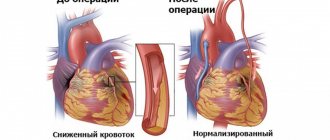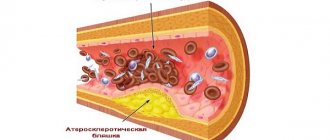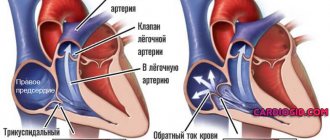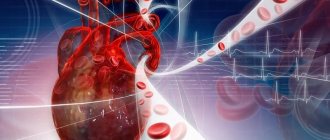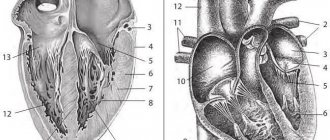ST segment changes
Normally, the ST segment is located on or near the isoline.
Estimates of ST tolerances vary slightly across studies. There may also be different approaches to measuring ST deviation.
The following ST segment displacements are considered pathological.
- Decrease (depression) in ST by 0.5 mm or more in V2-V3 and by 1 mm or more in other leads.
- Increase (elevation) of ST by 2 mm or more in V2-V3 and by 1 mm or more in other leads in men (in men under 40 years old, an increase in ST in V2-V3 to 2.5 mm is acceptable).
- by 1.5 mm or more in V2-V3 and by 1 mm or more in other leads in women
If in two or more than two adjacent leads the ST segment deviates from the isoline by more than the specified values, then this is a pathology.
ST deviation is usually measured at the J point (where the QRS complex enters the ST segment), as well as at ST60 (0.06 s from the J point) and ST80 (0.08 s from the J point).
When measuring the ST deviation at the J point, comparison is made with the level of the PR interval at the point of transition of the PR to the QRS complex. This is shown in diagram 1.
Diagram 1. J point and PR transition point
Schema source.
ECG 1 shows how ST segment displacement can be measured. In the example shown, an ST depression of 2 mm was recorded.
ECG 1. Fragment of a cardiogram with ST segment shift
Measuring the ST segment displacement not at point J, but at a distance of 0.08 s, i.e. 2 mm from the J point may be an alternative approach. This is especially true when there is an initial shift in the PR interval and ST segment due to the atrial repolarization wave.
The wave of atrial repolarization (indicated by Ta) is superimposed on the QRS complex and, as a rule, is not visible on the ECG. However, in some cases, the Ta wave becomes noticeable and displaces the PR interval, QRS and initial ST region.
Illustration of the phenomenon of atrial repolarization, which shifts the PR interval, QRS and initial ST segment in diagram 2. Here the Ta wave is shown in red dotted line.
Scheme 2. Atrial repolarization wave Ta
Schema source.
It is believed that the duration of the atrial repolarization wave does not exceed 0.08 s after the end of the QRS complex. In this regard, the ST displacement measurement is in some cases carried out at a distance of 0.08 s from the J point. The point at a distance of 0.08 s (2 mm) from the J point is called the I point or ST80. When displacement is assessed at ST80, comparison is made with the TP interval (between the T wave and the P wave) rather than with the PR interval.
ECG 2 shows an example when the atrial repolarization wave simulates ST segment depression. A cardiogram was taken from a 25-year-old patient with complaints of chest discomfort. The patient abuses caffeine. The recording showed tachycardia and ST depression in leads II, III, aVF and V2-V6. However, if you look closely, you can also see that the PR segment has an oblique, downward shape. This is due to the atrial repolarization Ta wave, which also shifts ST downward. If you measure the ST level at point ST80 (2 mm after the J point) and compare it with the level of the TP segment, then there will be no significant depression.
ECG 2. ST shift caused by a pronounced wave of atrial repolarization
ECG source.
However, in the case of ECG 2, even without this adjustment, there was no evidence of ischemia, because the shape of the ST segment is obliquely ascending. Ischemia is characterized by downward or horizontal ST depression. Morphological assessment of ST segment changes is more important than assessment of displacement using one or another technique.
A displacement of the ST segment above or below its normal position can occur in different types of coronary artery disease, as well as in other heart pathologies (for example, with blockade of the ventricular pathways, with ventricular hypertrophy, with tachycardia and in other cases).
Different authors and different guidelines suggest different ways to measure ST levels, but everyone agrees that assessing the morphological pattern allows a more accurate conclusion to be made. Therefore, in order to understand what causes ST deviation in each specific case, you need to know the morphological variants of ST displacement.
Decrease in ST segment in coronary artery disease
Look at Chart 3 for examples of ST segment depression. A sign of ischemia may be horizontal or downsloping ST depression. Oblique ST depression is not a sign of ischemia.
Scheme 3. Variants of ST depression
Schema source.
ST segment depression can occur in stable angina, unstable angina, and infarction without ST segment elevation.
- With subendocardial ischemia, oblique or horizontal depression is usually recorded in many leads: I, II, V4-V6, as well as in other leads. An example of such ischemia is shown in ECG 3.
- ST depression associated with subendocardial ischemia is usually associated with ST elevation greater than 1 mm in lead aVR. ST elevation in aVR is reciprocal (mirror) to diffuse depression in the chest leads. In addition, ST elevation in aVR may indicate occlusion of the left main coronary artery (LMCA). An example of ST elevation in aVR combined with ST depression in many leads is also seen in ECG 3.
- If the number of leads in which there is ST depression is limited to one region (for example, only in the inferior leads), this may be due to reciprocal (mirror) changes in relation to ST elevation during myocardial infarction. Example on ECG 4.
ECG 3. Decrease in the ST segment with subendocardial myocardial ischemia
ECG source.
ECG 3 showed a decrease in ST in I, II, V4-V6. This is a sign of subendocordial ischemia. In addition, the cardiogram shows an increase in the ST segment in lead aVR, which indicates a narrowing of the left main coronary artery (LMCA).
ST segment elevation in ischemic heart disease
ST segment elevation is associated with transmural or subepicardial ischemia.
Look at Chart 4, which shows two typical types of ST elevation: concave and convex. IHD is characterized by convex elevation.
Diagram 4. Concave and convex ST elevation
Schema source.
In coronary artery disease, ST segment elevation can occur with a heart attack with ST elevation, with Prinzmetal's angina, as well as with post-infarction ventricular aneurysm.
ECG 4 shows an example of ST elevation in leads I, aVL, V2-V6, indicating myocardial infarction in the region of the anterior and lateral walls of the left ventricle. In addition to elevation, the cardiogram shows ST depression in the inferior leads (III, aVF). These are reciprocal (i.e., mirror) changes, reflecting the same process as ST elevation in I, aVL, V2-V6, but in leads located on the other side of the infarction area. In general, if the cardiogram shows ST depression, characteristic of ischemia, in a large number of leads, then this indicates subendocardial ischemia. And if such depression is recorded in a limited number of leads, as in ECG 4, then these are, as a rule, reciprocal changes associated with ST elevation infarction.
In addition, ECG 4 recorded pathological Q waves (in this case, QS complexes) in leads V2-V4. Pathological Q is a sign of necrosis.
ECG 4. Increased ST segment during myocardial infarction
ECG source.
Diagnosis of myocardial infarction in children
Myocardial infarction is an acute disease caused by the occurrence of one or more foci of ischemic necrosis in the heart muscle due to absolute or relative insufficiency of coronary blood flow. Most pediatricians and cardiologists believe that myocardial infarction in childhood belongs to the section of casuistry. Atherosclerosis of the coronary arteries, which is the main cause of myocardial infarction in adults, practically does not occur in children, with the exception of cases of familial hyperlipidemia [3, 6]. That is why many pediatricians are not wary when making this diagnosis. It is interesting to note that the US National Library of Medicine specifically records every case of myocardial infarction in children described in the world medical literature [5].
The incidence of myocardial infarction in children is unknown. However, this disease is much more common than is commonly believed. It is known, for example, that with congenital heart defects, even in the absence of structural abnormalities of the coronary vessels at autopsy, infarct areas in the myocardium were detected in 75% of cases, and half of them could be diagnosed clinically [4].
If in adults the main cause of myocardial infarction is atherosclerotic damage to the coronary arteries, then in children this etiological factor ranks last in terms of prevalence. The most common causes of myocardial infarction are inflammatory diseases of the coronary arteries - coronaritis and anomalies of the coronary arteries. Let us list the main causes of myocardial infarction in children.
- Coronaritis, including: non-rheumatic carditis, infectious diseases, Kawasaki disease, Takayasu disease, systemic lupus erythematosus, periarteritis nodosa, nonspecific aortoarteritis.
- Anomalies of the coronary arteries, including: the origin of the left coronary artery from the pulmonary artery (Bland-White-Garland syndrome), anomalies in the number of coronary arteries, other anomalies of the coronary arteries.
- Trauma to the heart and coronary arteries.
- Pheochromocytoma.
- Congenital heart disease (supravalvular aortic stenosis).
- Hypertrophic cardiomyopathy.
- Heart tumor.
- Infectious endocarditis.
Currently, myocardial infarction with a Q-wave (transmural myocardial infarction) and myocardial infarction without a Q-wave (fine-focal, subendocardial, intramural) are distinguished. In the first case, a pathological Q wave or QS complex is formed on the ECG; in the second, changes concern only the T wave and the ST segment.
The diagnosis of myocardial infarction also indicates the features of its course (primary, repeated, recurrent) and complications.
According to localization, they are distinguished: anterior (apical, lateral, septal, widespread anterior), inferior (diaphragmatic), posterior and inferobasal. These locations refer to the left ventricle, which is most often affected by this disease. Right ventricular infarction is extremely rare.
Clinic
The clinical manifestations of myocardial infarction of any etiology in children are similar: these are attacks of sudden anxiety in young children and a typical anginal status in older ones. Much less often, a heart attack occurs without pain. When examined in children, as a rule, pale skin, cyanosis, cold extremities, sweating, tachypnea or dyspnea, and arterial hypotension are noted. Some children may experience signs of gastrointestinal dysfunction that are of reflex origin - abdominal pain, nausea, vomiting, diarrhea. Signs of circulatory failure develop mainly in the pulmonary circulation (tachycardia, shortness of breath, cough). Somewhat less often, patients exhibit liver enlargement, less often - swelling of the legs, which indicates the addition of right ventricular failure.
Some children may develop cardiogenic shock (cold gray-pale skin covered with sticky sweat, oligoanuria, thready pulse, decreased pulse pressure less than 20-30 mmHg, decreased systolic pressure). The decrease in coronary blood flow that occurs during cardiogenic shock aggravates the decrease in the pumping function of the heart and the course of cardiogenic shock, the development of pulmonary edema - the main causes of death in myocardial infarction.
The course of myocardial infarction can be complicated by the occurrence of arrhythmias (extrasystole, atrial fibrillation, paroxysmal tachycardia, ventricular fibrillation), thromboembolism, the development of acute and the formation of chronic cardiac aneurysm.
Diagnostic criteria
The diagnosis of myocardial infarction is confirmed using instrumental and laboratory research methods.
It is known that electrocardiography is of greatest importance for diagnosing ischemia [5]. An ECG in the ischemic stage shows a rise in the ST segment in the so-called “straight” leads (in these leads a pathological Q wave or QS complex will subsequently form) and a reciprocal decrease in the ST segment in leads in which there will be no change in the QRS complex. In the acute phase, in the “direct” leads during transmural myocardial infarction, the R wave sharply decreases or completely disappears and the QS complex is formed. With less depth of necrosis of the myocardial wall, a pathological Q wave appears in the “direct leads” (equal in amplitude to 1/3 of the R wave or more, lasting 0.04 s or more). Subsequently, the ST segment returns to the isoline and a negative “coronary” T wave is formed in the “straight” leads (Fig. 1).
| Figure 1. ECG of a patient with transmural myocardial infarction of the inferior wall of the left ventricle and reciprocal changes in the precordial leads |
In case of subendocardial infarction, ECG changes are limited to ST segment depression and T inversion in the “straight” leads (Fig. 2).
When necrosis is localized in the area of the anterior wall of the left ventricle, changes on the ECG are characteristic in leads I, aVL, V1-6: for infarction of the lateral wall - in leads I, aVL, V5,6; if the septal area is affected, changes are detected in leads V1,2( 3), with a heart attack in the region of the apex of the heart - in leads V3,4. Infarction of the inferior wall is characterized by changes in leads II, III, aVF.
| Figure 2. ECG (chest leads) for anterior myocardial infarction without a Q wave |
A sign that suggests the presence of an aneurysm is the so-called “frozen” ECG: persistence of ST segment elevation in combination with the QS complex in the “straight” leads, with a possible T wave.
Resorption-necrotic syndrome during myocardial infarction is confirmed by the results of general clinical and biochemical blood tests: leukocytosis with a shift in the leukocyte formula to the left, an increase in ESR from the third to fifth day, an increase in the blood activity of creatine phosphokinase (CPK) and its MB-fraction, aminotransferases (especially aspartic and to a lesser extent alanine) and lactate dehydrogenase (general) and its first and second isoenzymes. Assessing the state of the hemostasis and fibrinolysis system allows us to identify hypercoagulable changes.
In recent years, new markers have been widely used: troponin T, troponin I and myoglobin. Troponin is a protein complex that regulates muscle contraction and consists of 3 subunits - troponin T, troponin C and troponin I. In the early 90s. Immunological methods have been developed that make it possible, using monoclonal antibodies, to distinguish troponins T and I of cardiomyocytes and other striated muscle fibers. It is believed that troponins T and I are the most informative and sensitive markers of cardiac muscle necrosis. Their level increases in the blood within 2-3 hours after myocardial infarction, can increase 300–400 times compared to normal and remains elevated for 10–14 days. Unfortunately, these methods are still very rarely used in the diagnosis of myocardial infarction in children.
The diagnosis of myocardial infarction is confirmed by echocardiography. Diagnostic criteria are the presence of zones of akinesia (area of necrosis), hypokinesia, asynchrony of contractions of individual segments of the left ventricle in the area of ischemic damage. In the future, some patients may develop a left ventricular aneurysm. In areas of undamaged segments, phenomena of dyskinesia or hyperkinesia of a compensatory nature are determined. In cases where it is not possible to clearly visualize the initial sites of origin of the left coronary artery, one can think of an anomaly of the coronary arteries. Chest X-ray is not very informative for diagnosing myocardial infarction. Cardiomegaly indicates an underlying disease (carditis, congenital heart disease, anomalous origin of the coronary arteries) and may also be associated with a cardiac aneurysm. In patients with left ventricular failure, an increase in the vascular pattern is observed.
It is known that coronary angiography and ventriculography provide the most accurate diagnosis of damage to the coronary arteries [2]. These studies make it possible to clearly establish the location, nature and extent of damage to the coronary arteries, to identify a decrease in myocardial contractility, and sometimes a left ventricular aneurysm. Unfortunately, they are underutilized in pediatric cardiology.
Recently, myocardial scintigraphy or myocardial positron emission tomography has been used to diagnose myocardial infarction. These methods make it possible to non-invasively assess myocardial perfusion, the volume and localization of destructive changes, and identify metabolic disorders.
Inflammatory diseases of the coronary vessels
One of the most common causes of myocardial infarction in children is inflammatory diseases of the coronary arteries - coronaritis. The true prevalence of coronaritis due to the complexity of diagnosis is not known; in most cases, this diagnosis is made at autopsy. The inflammatory process often involves three vessel membranes simultaneously [1]. Coronaritis often accompanies carditis and can lead to the development of myocardial infarction [4]. Thus, according to our data, in 6 young children, a clinical picture of a typical myocardial infarction developed against the background of acute carditis.
Acute coronaritis can occur with various infectious diseases (influenza, scarlet fever, typhus, etc.). We observed a boy S., 6 months old, with a generalized form of salmonella infection, who after 2 weeks. From the onset of the disease, transmural myocardial infarction of the left ventricle was observed, followed by the development of a left ventricular aneurysm. Figure 3 shows an electrocardiogram of patient S., 6 months old, with transmural myocardial infarction, the cause of which was coronaritis that arose against the background of a generalized Salmonella infection.
| Figure 3. ECG of patient S., 6 months |
Often the cause of myocardial infarction can be Kawasaki disease. The lack of statistical data regarding this disease in Russia is due to the lack of awareness among pediatricians. Kawasaki disease is included in ICD-10 under the name “mucocutaneous lymphonodular syndrome” (code 178.010). Currently, Kawasaki disease is considered as a vasculitis of unknown etiology with a fever syndrome and predominant damage to the coronary arteries, which occurs more often in young children [2, 7].
The main criteria for diagnosing Kawasaki disease are fever over 38°C or higher for 5 days or more in combination with at least 4 of the 5 symptoms listed below:
- polymorphic exanthema;
- damage to the mucous membranes of the oral cavity (diffuse erythema of the oral mucosa, catarrhal tonsillitis and/or pharyngitis, “strawberry” tongue, dryness and cracked lips);
- bilateral catarrhal conjunctivitis;
- acute non-purulent cervical lymphadenitis;
- changes in the skin of the extremities (hyperemia and/or swelling of the palms and feet, peeling of the skin of the extremities).
The listed symptoms are observed in the first 2–4 weeks. diseases. Heart damage can be of the type of myocarditis and/or coronaritis with the development of multiple aneurysms and occlusions of the coronary arteries, which can subsequently lead to myocardial infarction. We observed 3 children with Kawasaki disease, coronary artery disease, and myocardial infarction.
The causes of coronaritis can be nonspecific aortoarteritis, periarteritis nodosa, infective endocarditis, hemorrhagic vasculitis.
Nonspecific aortoarteritis (Takayasu's disease, pulseless disease, multiple obliterating panarteritis) is characterized by inflammatory and destructive changes in the wall of the aortic arch and its branches, accompanied by their stenosis and ischemia of the blood supplying organs. In this case, damage to the coronary arteries is often noted. At the onset of the disease, weakness, weight loss, dizziness, pain in the chest and limbs, anemia, fever, pericarditis, iridocyclitis, and edema occur. In the future, complaints of numbness of the extremities may appear, and in some cases neurological symptoms are added. The examination reveals the absence of a pulse, most often in the area of the radial, ulnar and carotid arteries. Pressure asymmetry is characteristic. Auscultation of the carotid, subclavian arteries and abdominal aorta helps diagnose arteritis. Persistent pain in the heart, ischemic and cicatricial changes on the ECG help to suspect concomitant coronary artery disease.
In the pathogenesis of myocardial infarction in Takayasu's disease, along with coronaritis and subsequent stenosis of the left or right coronary arteries, arterial hypertension, as well as relative coronary insufficiency due to myocardial hypertrophy, are important.
We observed 2 cases of myocardial infarction in children with aortoarteritis. An 11-year-old boy was sent to the hospital with suspected pheochromocytoma. The examination did not confirm the diagnosis. Nonspecific aortoarteritis was detected with damage to the aortic arch, occlusion of the celiac trunk, left subclavian and both renal arteries. A transaortic endarterectomy was performed from the aorta (supra-, inter- and infrarenal sections), celiac trunk, superior mesenteric and both renal arteries, and plastic surgery of the aorta with a synthetic patch. After 3 weeks After the operation, complaints of “squeezing” pain in the heart appeared, the child was again hospitalized. Death occurred from extensive myocardial infarction of the posterolateral wall of the left ventricle, resulting from damage to the coronary arteries.
With aortoarteritis, the valvular apparatus of the heart may also be involved in the process. Thus, a 10-year-old girl had aortic regurgitation, which arose as a result of inflammation of the aorta and aortic valve ring, damage to the mitral valve, the phenomenon of myocarditis with subsequent transformation into dilated cardiomyopathy, with signs of circulatory failure of degree IIB. Myocardial infarction occurred against the background of malignant arterial hypertension caused by stenotic and thrombotic occlusion of the carotid and renal arteries.
Damage to the coronary arteries can occur with diffuse connective tissue diseases. We observed a girl S., 15.5 years old, with systemic lupus erythematosus (sick for 7 years). The patient experienced pressing pain in the heart area, which the clinic doctor explained as osteochondrosis. And only 2 days later an ECG was done, which revealed changes indicating subendocardial myocardial infarction of the lateral wall and apex of the left ventricle. The examination excluded the presence of antiphospholipid syndrome as a possible cause of myocardial infarction in a patient with systemic lupus erythematosus. In all likelihood, myocardial infarction in this case was associated with chronic inflammatory changes in small or large coronary vessels, which could lead to gradual narrowing of the lumen and thrombosis. It should be noted that a year after myocardial infarction, complete normalization of the ECG pattern was noted.
Anomalies of the coronary arteries
Another most common cause of myocardial infarction in children is congenital anomalies of the coronary arteries. They can occur in isolation and in combination with congenital heart defects (stenosis and coarctation of the aorta, tetralogy of Fallot, etc.). Frequently occurring (0.3% of the total number of unselected autopsies) anomalies of the coronary arteries are represented by an unusual number of vessels, their mouths, and the location of the main trunks. An explanation for the high frequency of congenital anomalies can be found in the characteristics of the embryonic development of the coronary system. Differences in the development of coronary arteries in comparison with vascular formations in any other organs are the fusion of proximal (from the aortopulmonary trunk) and distal (secondary and tertiary vessels from myocardial sinusoids) arteries, as well as the dependence of vessel growth on the growth of the myocardium itself. The occurrence of myocardial infarction with congenital anomalies of the coronary arteries is caused by: direct deficiency of myocardial perfusion; the phenomenon of “stealing” (steal phenomenon); functioning of the coronary artery as a venous drainage (coronary fistula).
The most common congenital pathology of the coronary vessels is the anomalous origin of the left coronary artery from the pulmonary artery (ALCA from PA) - Bland-White-Garland syndrome. The frequency of this syndrome, according to the literature, is 0.25–0.5% of all congenital heart defects [1, 4]. According to one of the hypotheses, this pathology is based on the incorrect formation of one of the coronary arteries in that part of the trunk from which the pulmonary artery is subsequently formed; the division of the main trunk is not disturbed. We observed 7 patients aged from 2 months. up to 6 years of age, the cause of myocardial infarction in whom was anomalies of the coronary arteries, of which 5 children had an anomalous origin of the left coronary artery from the pulmonary artery - Bland-White-Garland syndrome.
Issues of hemodynamics in AOLCA from PA still remain controversial. It was previously thought that the only factor causing myocardial ischemia was the decrease in pulmonary artery pressure after birth, leading to a drop in perfusion pressure in the anomalous left coronary artery. Using coronary angiography, it was possible to show that blood into the left coronary artery does not come from the pulmonary artery, but through intercoronary anastomoses from the right coronary artery arising from the aorta, i.e., a discharge occurs from the area of high pressure (aorta, right coronary artery) to the area lower pressure (left coronary artery, pulmonary artery). In this regard, the survival of patients with this pathology determines the collateral blood flow in the myocardium at the time of birth and thereafter. It should be noted that well-developed intercoronary anastomoses are not always able to prevent myocardial ischemia due to low perfusion pressure as a result of blood flow through collaterals from the right to the left coronary artery and further to the pulmonary artery (coronary steal syndrome). With severe “steal syndrome,” the subendocardial blood flow is especially affected. This is one of the causes of endomyocardial fibroelastosis in this disease.
According to clinical and instrumental indicators and prognosis, there are 2 types of Bland-White-Garland syndrome: “infantile”, with poorly developed collaterals of the coronary arteries, and “adult”, in which there is a large number of intercoronary anastomoses that ensure long-term survival.
The first clinical manifestations in most patients can be noted already in the first 3 months. life, less often in the second half of the year. All the children we observed with AOLCA from LA had attacks of sudden anxiety, shortness of breath, sweating, threadlike pulse, and a pained expression on their face. Such attacks are called “angina pectoris” in the literature due to their similarity with the clinical picture of angina pectoris in adults [1]. Between attacks, the children looked calm, but shortness of breath persisted. Children were lagging behind in physical development. On examination, a left-sided cardiac hump was noted. The borders of the heart were expanded to the left, the apical impulse was diffuse, weakened, displaced into the sixth-seventh intercostal space. Heart sounds were muffled, a murmur of mitral valve insufficiency was heard, the cause of which was most likely associated with ischemia or infarction of the papillary muscles, dilatation of the left ventricular cavity, and deformation of the mitral valve leaflets.
An important place in the diagnosis of AOLCA from PA is given to the electrocardiography method. As a rule, the ECG shows a deviation of the electrical axis of the heart to the left due to blockade of the anterior left branch of the His bundle and characteristic electrocardiographic changes are revealed: a deep, widened Q wave in leads I, aVL, V5-6, maximally in aVL (Fig. 4). In the stage of decompensation, changes are often combined with a rise in the S-T segment above the isoline by 3-6 mm and a decrease in the amplitude of the R wave, which corresponds to the picture of an acute infarction. A “dip” in the amplitude of the R wave in leads V3 and V4 (the morphology of the ventricular complex becomes rS, QS, Qr), indicating a previous infarction, has diagnostic significance in case of AOLCA from PA.
| Figure 4. ECG of child G., 3 months, with AOLCA from PA and apical-lateral myocardial infarction |
On a chest x-ray in children with AOLCA from PA, cardiomegaly is noted, mainly due to the left parts. Indirect evidence of anomalous origin of the coronary arteries is the inability to clearly visualize the initial sections of the left coronary artery during echocardiography [2].
The diagnosis is confirmed using selective coronary angiography (a contrast agent is injected through the dilated trunk of the right coronary artery, while retrograde filling of the left coronary artery system through intercoronary anastomoses is visible, followed by contrasting of the pulmonary artery).
The prognosis for AOLCA from LA without surgery is in most cases unfavorable. Life expectancy is determined by the severity of intercoronary anastomoses, “steal syndrome,” cardiosclerosis and fibroelastosis. If patients survive a critical period of life (1-2 years), then later they undergo surgery. Children over 2 years of age tolerate ligation of the left coronary artery well. Radical surgery for AOLCA from PA consists of transplanting the left coronary artery into the aorta directly or through a prosthesis. This operation is more physiological, as it preserves the bicoronary blood supply system of the heart. However, due to anatomical features, it is not always feasible in young children.
Trauma to the heart and coronary arteries
The cause of myocardial infarction in children can be closed injuries to the heart and coronary arteries. We observed 2 such children. Thus, a 3-year-old boy developed a myocardial infarction 7 days after his chest was compressed by a huge dog. In a state of extreme severity, the child was taken to the hospital by ambulance with an erroneous diagnosis of pneumonia. The ECG recorded signs of transmural myocardial infarction of the anterior wall of the left ventricle. The pathogenesis of the development of myocardial infarction during cardiac injury is most likely associated with hemorrhage into the myocardium, which could spread to the coronary arteries with the subsequent development of sclerotic changes and stenosis. Thus, the second boy, 13 years old, developed subintimal hemorrhage with moderate occlusion of the left coronary artery after a closed chest injury in a car accident. A feature of this case was the long-term (after 3 years) development of myocardial infarction during intense physical activity. According to the literature, complete or partial ruptures of the coronary arteries with the formation of an arterial aneurysm or coronary fistula are also possible [8]. The narrowing of the lumen of the coronary arteries during trauma is facilitated by spasm and increased platelet aggregation [9].
It should be remembered that with a closed heart injury, the conduction system may be damaged, although often signs of its damage (intraventricular block, complete and incomplete atrioventricular block) may appear only several months or years after the injury. This dictates the need for regular examination by a doctor over a long period of time (including electrocardiographic examination) of children with chest injuries.
Sometimes myocardial infarction can occur in patients with pheochromocytoma. The development of myocardial infarction in these cases is facilitated by prolonged hypercatecholaminemia, which is accompanied by high arterial hypertension, left ventricular myocardial hypertrophy, and thickening of the walls of the coronary arteries. The phenomena of coronary spasm and hypercoagulable changes associated with hypercatecholaminemia also have a certain significance in the development of myocardial infarction. According to our observations, pheochromocytoma was the cause of myocardial infarction in an 11-year-old boy.
Myocardial infarction often occurs in children with congenital heart defects (aortic stenosis). It may occur due to a deficiency of coronary blood flow. We observed for several years a patient with Williams-Beuren syndrome, a congenital heart defect (supravalvular aortic stenosis), who developed a fatal myocardial infarction at the age of 13.
We also observed several patients in whom myocardial infarction complicated the course of such serious diseases as hypertrophic cardiomyopathy, heart tumor, and infective endocarditis. Thus, in a 4-year-old girl with infective endocarditis and large vegetations on the aortic valve, the course of the disease was complicated by embolism of the left coronary artery and the development of acute transmural myocardial infarction. Myocardial infarction due to a heart tumor (left atrial myxoma) developed in a 6-year-old boy.
Thus, other diseases can complicate the development of myocardial infarction, which, in turn, can influence the course of many serious diseases. Therefore, increased attention is required from doctors in such cases.
For questions regarding literature, please contact the editor.
L. V. Tsaregorodtseva , candidate of medical sciences, associate professor of Russian State Medical University, Moscow
T wave changes in ischemic heart disease
With ischemic heart disease, the T wave can be changed in two situations.
- With ischemia associated with an attack of angina, a negative T wave may be recorded in two (or more than two) adjacent leads.
- In the acute phase of myocardial infarction with ST elevation, a high positive T may be recorded.
Look at ECG 5 with an example of ischemia and inverted T waves.
ECG 5. Negative T waves in myocardial ischemia
ECG source.
ECG 5 shows inverted T waves in the left leads: V5-V6, I, aVL.
Negative T values indicate ischemia if the following conditions are met.
- The depth of negative T must be at least 1 mm.
- Negative T waves must be recorded in at least two adjacent leads.
- The QRS complex before the negative T has a tall positive R wave.
- Dynamics of change. These should be “new” inverted Ts (they should not be on old cardiograms). Within some time (hours or days) there should be a return of the T wave to the isoline.
In addition, it should be remembered that inverted T wave in leads III, aVR, V1 is a normal variant.
ECG 6 shows another example of a change in the T wave in coronary artery disease: high coronary T wave in the acute phase of myocardial infarction with ST elevation. This is the initial and very short period of a heart attack, so it is not always possible to register it on an ECG.
ECG 6. High positive T wave in the acute phase of myocardial infarction
ECG source.
Stages of ECG changes in acute transmural myocardial infarction
The earliest changes in acute transmural myocardial infarction usually occur in the ST-T complex and include two successive stages.
Acute stage
ST segment elevation, sometimes tall positive T waves.
Subacute stage (developmental stage)
Takes hours or days. It is characterized by deep negative T waves in leads where there was previously ST segment elevation.

